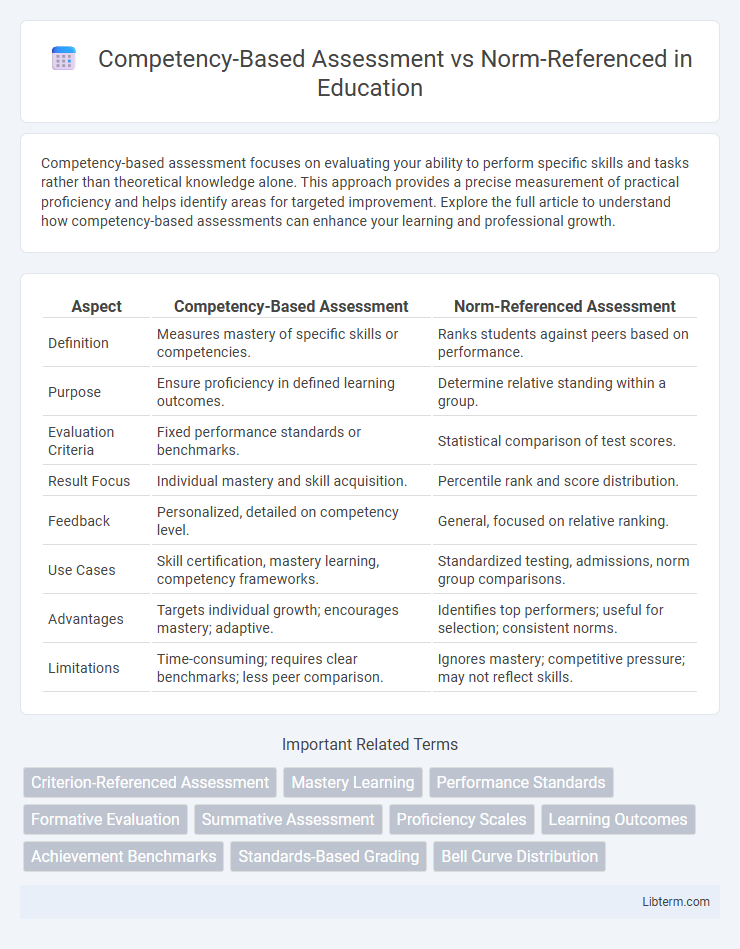Competency-based assessment focuses on evaluating your ability to perform specific skills and tasks rather than theoretical knowledge alone. This approach provides a precise measurement of practical proficiency and helps identify areas for targeted improvement. Explore the full article to understand how competency-based assessments can enhance your learning and professional growth.
Table of Comparison
| Aspect | Competency-Based Assessment | Norm-Referenced Assessment |
|---|---|---|
| Definition | Measures mastery of specific skills or competencies. | Ranks students against peers based on performance. |
| Purpose | Ensure proficiency in defined learning outcomes. | Determine relative standing within a group. |
| Evaluation Criteria | Fixed performance standards or benchmarks. | Statistical comparison of test scores. |
| Result Focus | Individual mastery and skill acquisition. | Percentile rank and score distribution. |
| Feedback | Personalized, detailed on competency level. | General, focused on relative ranking. |
| Use Cases | Skill certification, mastery learning, competency frameworks. | Standardized testing, admissions, norm group comparisons. |
| Advantages | Targets individual growth; encourages mastery; adaptive. | Identifies top performers; useful for selection; consistent norms. |
| Limitations | Time-consuming; requires clear benchmarks; less peer comparison. | Ignores mastery; competitive pressure; may not reflect skills. |
Introduction to Assessment Paradigms
Competency-based assessment evaluates individuals based on their ability to demonstrate mastery of specific skills or knowledge, emphasizing personalized learning outcomes and practical application. Norm-referenced assessment compares an individual's performance to a predetermined group, ranking scores to determine relative standing within the population. These contrasting paradigms highlight the shift from traditional evaluative methods toward more individualized and competency-focused approaches in educational and professional settings.
Defining Competency-Based Assessment
Competency-Based Assessment evaluates a learner's mastery of specific skills or knowledge against predefined criteria, rather than comparing performance to peers. This approach emphasizes personalized feedback and practical application, ensuring individuals meet essential competencies required for their role or field. It enables targeted development by focusing on demonstrated abilities rather than relative ranking.
Understanding Norm-Referenced Assessment
Norm-referenced assessment evaluates a student's performance by comparing it to a predefined group, typically providing percentile ranks or standardized scores to indicate relative standing. This method identifies how an individual's achievements align with their peers, often used for selection and placement decisions in educational settings. Its emphasis lies in ranking students rather than measuring mastery of specific skills or competencies.
Key Differences Between the Two Approaches
Competency-based assessment evaluates learners against predefined skills and knowledge criteria, emphasizing individual mastery and practical application. Norm-referenced assessment compares a learner's performance to peers, highlighting relative ranking and percentile scores. The key difference lies in competency-based assessment's focus on meeting specific standards, while norm-referenced assessment prioritizes relative performance within a group.
Advantages of Competency-Based Assessment
Competency-based assessment emphasizes mastery of specific skills and knowledge, ensuring learners meet clearly defined standards relevant to real-world applications. It allows personalized learning paths and timely feedback, promoting continuous improvement and self-paced progression. Unlike norm-referenced assessments, competency-based methods prioritize individual achievement over relative ranking, enhancing learner motivation and practical competence.
Benefits of Norm-Referenced Assessment
Norm-referenced assessment provides valuable comparative data by evaluating a student's performance against a representative peer group, allowing educators to rank and identify relative strengths and weaknesses effectively. This approach supports large-scale standardized testing, enabling consistent benchmarking across diverse populations and informing policy decisions. Its ability to highlight achievement gaps and inform resource allocation makes it essential for maintaining educational equity and accountability.
Challenges and Limitations of Each Method
Competency-Based Assessment often faces challenges such as subjective evaluation criteria, difficulties in standardizing performance benchmarks across diverse learners, and the resource-intensive nature of individualized assessments. Norm-Referenced Assessment struggles with inherent limitations like promoting competition over mastery, lacking specific feedback for skill improvement, and potentially misrepresenting an individual's true competence by focusing solely on relative ranking. Both methods require careful implementation to balance fairness, accuracy, and the meaningful measurement of learner abilities.
Applications in Educational Settings
Competency-based assessments measure students' mastery of specific skills and knowledge, allowing for personalized learning plans and targeted interventions in educational settings. Norm-referenced assessments rank students against peers, providing comparative data useful for identifying achievement gaps and informing curriculum adjustments. Schools increasingly adopt competency-based methods to foster skill proficiency and real-world readiness, while norm-referenced tests remain valuable for standardized benchmarking and college admissions.
Impact on Learner Development and Outcomes
Competency-based assessment directly measures learner mastery of specific skills and knowledge, promoting personalized learning paths and fostering deeper understanding and practical application. Norm-referenced assessment compares learners against each other, often emphasizing competition rather than individual growth, which can limit motivation and overlook unique developmental needs. Emphasizing competency-based assessment leads to improved learner outcomes by ensuring readiness for real-world challenges and supporting continuous skill advancement.
Choosing the Right Assessment Approach
Competency-based assessment evaluates an individual's mastery of specific skills and knowledge, emphasizing personalized learning outcomes and practical application, while norm-referenced assessment ranks individuals against a peer group to determine relative performance. Choosing the right assessment approach depends on the objective: competency-based assessments are ideal for measuring proficiency and readiness for real-world tasks, whereas norm-referenced assessments suit contexts requiring comparative performance analysis. Organizations should align their assessment strategy with their goals, whether fostering skill development or benchmarking against standards.
Competency-Based Assessment Infographic

 libterm.com
libterm.com